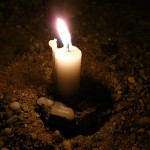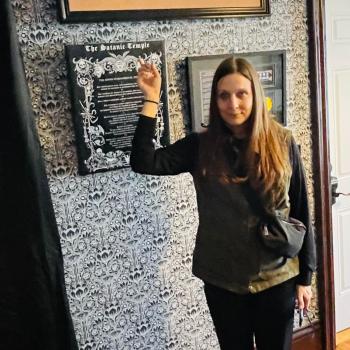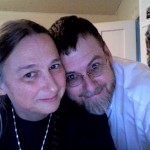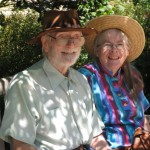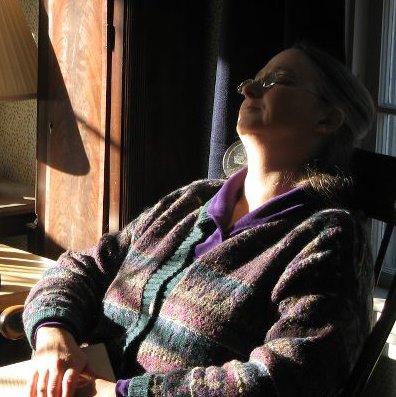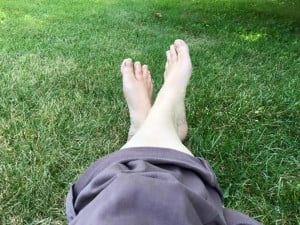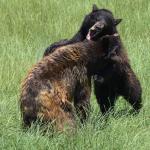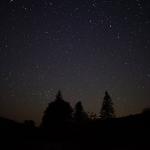I was twenty-two the first time I made the ascent.
To those who dwell in the Western United States, Mt. Katahdin is hardly worthy of the name, “mountain.” At a mere 5,269 feet, it is dwarfed by even foothills in the Rocky Mountains. It isn’t even the highest in New England.
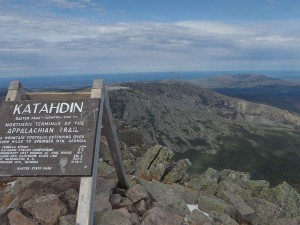
It is, however, a mountain that an athletic climber can manage from base to peak and back in a single summer’s day. And it is breathtaking: an isolated island in an ocean of air. Geology has made this mountain dramatic: the granite has been nibbled by glaciers, a giant’s cookie with Titanic bites taken out in four places. Mt. Katahdin has been narrowed by cirques, leaving places like the Knife Edge Trail to pick a way forward delicately, along a yard-wide path edged with a whole lot of nothing, a whole lot of air.
Up on the Knife Edge, you actually feel closer to the sun. The salt on your lips tastes different; the windburn on your cheeks is harsh, and strong, and exhilarating.
Then, too, not only is the trail narrow and bounded by cliffs… it wobbles.
They tell you, in the guidebooks, that they close the trail in windy weather. They tell you of the people who have died–generally from straying from the trail, onto what looks, from above like a “short cut” down to Chimney Pond. But they don’t tell you how the rocks and stones and boulders there are simply piled, one on the other, just as the glacier dropped them, like a spoiled child tired of his toys. They’re just rocks, piled on rocks. They balance, solidly or not, with no concern for Man.
I remember how, at twenty-two, crossing the Knife Edge for the first time, I was struck by that. I was standing in a place, almost for the first time in my life, that had not been designed with my comfort or safety in mind. Mountains don’t care. Mountains are there for their own reasons, and we are not it.
There are no handrails on a mountain. And it’s a long way down.
I was eighteen the first time a friend came out to me.
Her name wasn’t Jodee, but I’ll call her that, today. Jodee lived on the second floor of our dorm; I lived on the third. Gossip traveled between floors, but we were very insular, as freshman. So much of the time, that year, we traveled in anxious herds: fifteen girls heading out to a party… fifteen girls off to dinner at the Commons. All together, for fear that heading out on our own would cause offense. (Who would want to be young again, who remembers how it feels?)
The upshot was, the halls did not mix very much, and though I knew who Jodee was, I did not know her well until we became partners for a project in our astronomy class.
Sitting cross-legged on the bunks in my dorm room–laundry and dirty plates stacked here and there, sheets of paper torn and wadded up in rings around us where we worked–we crunched numbers on our calculators (numerators blurring into denominators as the night got old), calculating the red shifts of receding galaxies. There must have been cans of diet soda, bags of chips… I know there was laughter, and too many errors. I wore my eraser down to the metal cap.
And of course we talked of other things. Inconsequential things… just life.
And then the laughter stopped, and Jodee looked at me with such a weight of sadness in her eyes.
“There comes a time,” she said, “in all my friendships, when I have to decide. Do I tell, or do I not tell?”
I looked into her eyes, and I saw her struggling. She stood at one side of a precipice, and she saw me on the other.
I wanted to reach out to her; I wanted to take her hand, take her in a bear hug, something. I wanted to tell her, “I already know!” But I did not know how.
It was 1979 in Williamsburg, Virginia. The Stonewall riots had been only ten years before–not that I had heard of them by then–and a world and a half away. (It had only been sixteen years before when William and Mary had admitted its first black undergraduate. It had only been twelve years since the first black women were admitted–and housed in the basement of Jefferson Hall. My alma mater’s slogan was not “Three hundred years of tradition unhindered by progress” for nothing.)
1979 in Williamsburg, Virginia was not an easy time or place to be gay. I knew Jodee’s story, because it was a matter of common gossip. Jodee’s story… and Clara’s.
Jodee arrived at William and Mary knowing who she was, and knowing who she was able to love.
Clara, on the other hand, arrived with no sense of herself as lesbian. She may have dated–in high school or on campus. I have no idea. What I do know, what I remember clearly, was the absolute, stunning sweetness of her smile. There was just something about her: her smile, her voice, her long, honey-colored braids. I spent one afternoon in her company–possibly at the only football game I ever attended in college. We were with a large, jolly group, in any case, and I didn’t really get to talk to her. I only got to know her well enough to know she was someone I really wished I knew, though our paths never seemed to cross. She lived on the second floor as well, rooming with a plump, bouncy member of the Maranatha Christians.
That turned out to be a problem, of course, once Jodee met Clara, and Clara realized that it was Jodee, not the boys in the dorm next door who held her interest.
They tried to be low-key. They tried to keep it secret; they tried to be discreet. (Is there anything less possible than discretion from a teenager, in love for the first time?) Inevitably, they were discovered.
By the roommate. There was an ugly scene.
The roommate refused to share a dorm room with Clara any more. Rooms were reshuffled. Jodee and Clara were reassigned, together–not because the college wanted to support their feelings for one another, but because no one else was willing to room with a filthy dyke.
Said the story. Retold, on the third floor.
There was more to the story. Shunning, insults, disgrace. Dead rats were left at their door.
I heard these pieces in passing… in the bathroom, over the divider between the stalls, or in line for dinner, or for lunch.
“There comes a time,” I heard Jodee say to me, “when I have to make up my mind, whether or not to tell.”
How do you tell a friend, a friend who is just becoming a friend, that you already know what she is trying to say? How do you tell her your heart has broken for her, and you don’t know who said what or did what, or when or why, but you know that it was wrong, and you wish you could make it right?
More than not “minding” her gayness, I wanted to tell her… something. Something.
I see you. You are wonderful, perfectly imperfect, fine and more than fine. And you don’t have to tell me a goddam thing, Jodee, not because I already know, or not only that, but because it’s none of my business, it’s nobody’s business, not until and unless you say it is because I’m a friend you love and trust enough that it’s not a big decision to talk about our loves and our desires… Jodee, I see you, and you are my friend.
Full. Stop.
But I was eighteen.
I didn’t have the words. I didn’t know how to voice, even to myself, what my heart wanted to say.
So I said nothing, awkwardly. And Jodee came out to me–also awkwardly, but with more grace, I’m sure, than the answer I stammeringly must have made her, telling her, of course, it didn’t matter, I didn’t care, it was fine.
And it was–more or less.
Jodee and Clara moved off campus the next year, as I recall. I’m sure that was easier; the off-campus students were always hipper, less rigid than the lot in the dorms (or so I thought, stuck in the dorms myself). They broke up eventually, either because it was time, or because love in a world that leaves dead rats at your door is hard to sustain. I never knew.
This is as much of Jodee’s story as I have to tell you.
But I can tell you this: The human heart is wild, high, and life feels different there. Harsher, stronger, maybe even dangerous.
It has no handrails. And it’s a long way down.


